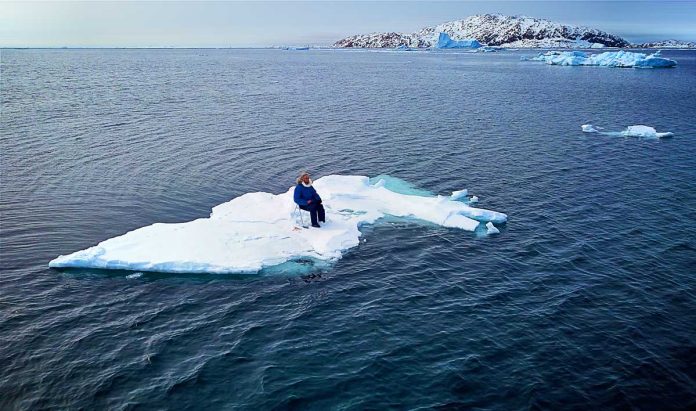What if we could visualise our contribution to the warming climate? This was the question I pondered as a visual artist headed to Greenland for PhD research. This 15.69m² sea ice floe that I sawed from the Arctic ice pack is how much ice cover would be lost from northwest Greenland by my fossil fuel emissions flying economy return, from Sydney, Australia to Upernavik, Greenland to film it: 5.23 tonnes of CO₂e.
Borrowing a peer reviewed scientific formula I was able to calculate this amount with a 10 per cent margin for error, inscribing the formula in the ice surface before sawing off the result. Less sea ice means that the Arctic Ocean’s dark surface absorbs more sunlight instead of reflecting it, warming the water further and creating what’s known as a feedback loop. A feedback loop in one of the planet’s most vulnerable tipping points: Arctic sea ice.
It’s not just artists asking these questions; citizens of developed countries are increasingly aware of correlations between their lifestyles and the climate crisis: witness the phenomenon of flygskam or “flying shame”. Air travel is one of the most polluting luxuries imaginable; only 11 per cent of the world’s population flew in 2018, and the greenhouse gases are emitted directly into the most potent location, the stratosphere.
During my month-long stay in Greenland, in May 2018, I met a local narwhal hunter who agreed to take me up to the nearest remaining sea-ice, 72° 55’ 53.84” N 56° 3’ 34.19” W. It had been a particularly bad year for ice in northwest Greenland and only after some kilometres of sailing, and much cautious prodding of potential sites with the hunter’s auger, did we find sea-ice thick enough for me to tentatively step upon it without plunging through.
I duly measured, pegged and sawed and was soon floating in Baffin Bay sitting atop a small, slowly-disintegrating drift of ice on a wonky chair with a piece of string, a foldable ruler and a rusting (now fairly blunt) saw.
After I’d stopped shaking (fear of slipping beneath the ice and the biting chill of sitting atop it now cancelling each other out) I gingerly sent up a drone to take some video.
The drone’s video link enabled me to look down upon my tiny melting island from above. At last I could visualise the impact of my fossil-fuelled lifestyle – an attribution that had hitherto remained conveniently invisible to me. Of course, it was much easier to stomach the idea that this particular chunk of ice would melt rather than that a specific living thing would die as a result of my choices.
We cannot be sure exactly where the carbon we are responsible for ends up, nor whom it will affect. And most individual fossil fuel footprints pale beside institutional contributions to planetary warming. But as I sat on the ice I had destroyed until it started to break up, I was at last able to grasp my tangible impact; it was no longer an abstract figure. And that was life-changing.
My self portrait featured in an Ocean Visuals collection at the 27th UN climate change conference in Egypt in November. COP27 was also where the world learned from a new report that Arctic sea ice is now “terminal”.
The sea ice will vanish during summers, probably within the next decade, as the Arctic warms four times faster than the rest of the planet. As sea ice researcher and co-author of the report, Robbie Mallett, said, “We’re starting to see something that can’t be saved.”
_______________
adamsebire.info/the-works/anthroposcenes/
climatevisuals.org/groupitem/103/





